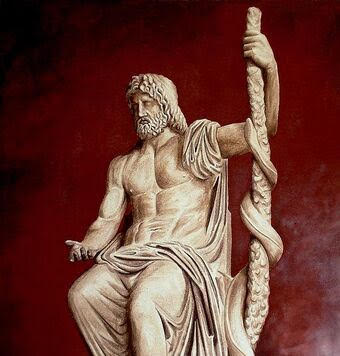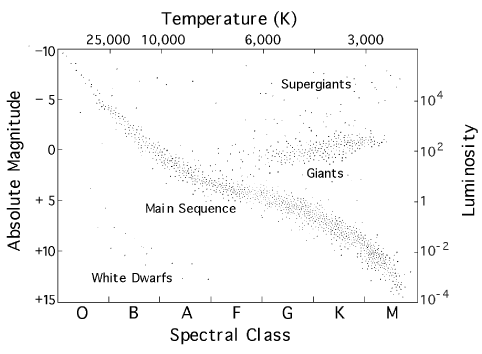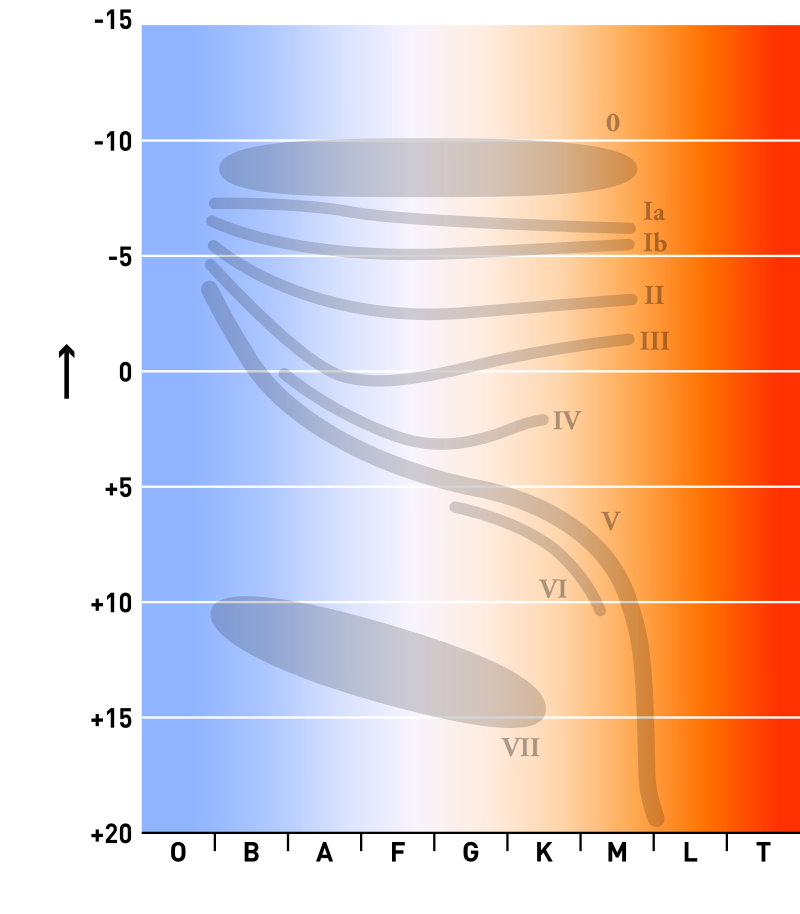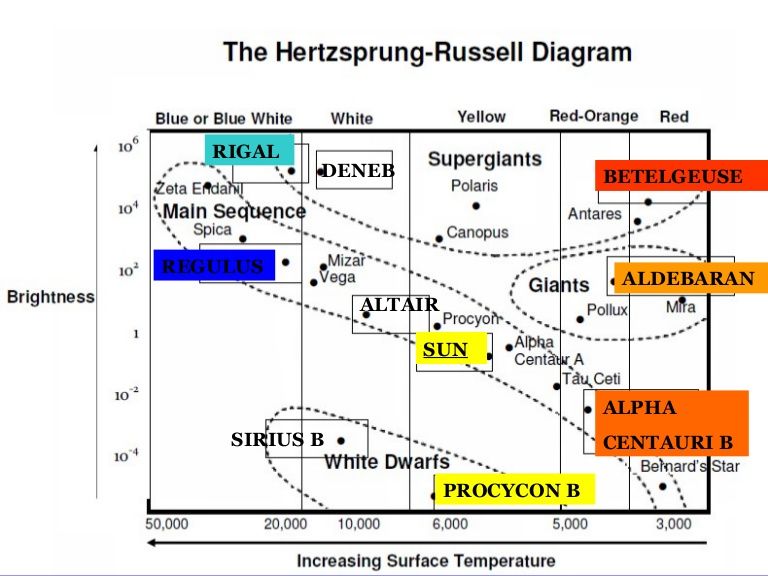Now that we've established the main sequence, we will start using the diagram to learn how to discern the properties of stars. We'll begin with two examples: Betelgeuse, Orion's eastern shoulder star and Sirius B, the companion star to Sirius, the brightest star in Canis Major.
BETELGEUSE:
Absolute magnitude: -5.85
Spectral type: M2
First, the absolute magnitude places Betelgeuse high along the H-R Diagram, while the spectral type places it well to the right. We see that Betelgeuse occupies a position toward the upper right of our diagram. What inferences can we now make about Betelgeuse based on the information provided?
- Betelgeuse is highly luminous. [It is more than 90,000 times more luminous than the Sun. This luminosity changes because Betelgeuse is a variable star. More on that topic later.]
- Betelgeuse is quite "cool." [As an M2 star, its effective temperature is approximately 3,600 K.]
- Since Betelgeuse is both cool, but highly luminous, we can also conclude it is quite large. Remember that a star's luminosity is proportional to the square of its surface area and to the fourth power of its effective temperature. [Betelgeuse's radius is approximately 900 times that of the Sun's.]
- As it is not on the main sequence, it is no longer fusing hydrogen into helium. We know that Betelgeuse is toward the end of its life cycle, but we cannot know precisely what fusion reactions are occurring in its core. All we know is that its core hydrogen fusion days are over.
- Betelgeuse is a supergiant star
SIRIUS B
Absolute magnitude: +11.18
Spectral type: A2
We can set Sirius B low on the H-R Diagram due to its high absolute magnitude. However, with a spectral type of A2, Sirius B would also be placed along the right. What can we conclude about Sirius B based on this information and its lower right position on the HR Diagram?
- Sirius B's luminosity is very low! [It is about 5% as luminous as the Sun.]
- Sirius B is quite hot. [With a spectral type of A2, Sirius B's effective temperature equals 25,000 K.]
- Since Sirius B is both cool, but not very luminous, it must be quite small. [Its radius is 0.8% that of the Sun.] In fact, Sirius B is not an active star at all. It is, instead, a stellar remnant known as a "white dwarf." It is no longer generating energy in its core through thermonuclear fusion reactions. We will be discussing white dwarf stars in greater detail later this week.
In these two examples, we were able to infer more information about these two stars merely by knowing their absolute magnitudes and spectral types. Before proceeding, we will introduce another stellar category: luminosity class.
- O-Ia+ Hypergiants.
Extremely rare form of high luminosity star. Example Cygnus OB2-12: luminosity 2 million times that of the Sun.
- Ia Luminous supergiants. Also quite rare. Luminosity more than a hundred thousand times that of the Sun. Example: Eta Carinae.
- Iab Intermediate luminous supergiants. Luminosity: tens of thousands of times greater than the Sun. Example: Betelgeuse
- Ib Less luminous Supergiants Stars that are just luminous enough to be classified as supergiants. Luminosities more than 10,000 times that of the Sun.
- II Bright giants Still highly luminous, but not considered supergiants due to their spectra. Luminosity thousands of times greater than the Sun's. Example: Omicron Scorpii
- III Normal giants Generally stars between 10 and a couple thousand times that of the Sun. Example: Arcturus
- IV Subgiants Stars that are more luminous than main sequence stars but not as luminous as giant stars. Example: Bellatrix
- V Dwarfs Main sequence stars. The luminosity is directly related to mass. Example: The Sun
- VI Subdwarfs Stars that are still fusing hydrogen into helium in their cores but are less luminous than main sequence stars. These stars are believed to be "metal poor," which decreases their outer layer opacity resulting in reduced radiation pressure. Example:
Kapteyn's Star
- VII White dwarfs. Stellar remnants. All thermonuclear fusion reactions have ceased. Example: Sirius B
Below we can see the different luminosity class locations within the H-R Diagram:
[Note: The L and T spectral types refer to "brown dwarfs," those gaseous bodies that did not become sufficiently massive to produce temperatures necessary for thermonuclear fusion reactions to occur. We will discuss brown dwarfs in greater detail later.]
Now that we've included these sections, the H-R Diagram will also enable us to determine a star's luminosity class.
Let's now classify some of the night sky's best known stars: Aldebaran, Altair, Antares and Deneb.
[Note: The Sun's absolute magnitude is 4.86. Any star with a lower absolute magnitude will be intrinsically brighter than the Sun. Any star with a higher absolute magnitude will be intrinsically fainter.]
Aldebaran (Taurus the Bull)
Absolute magnitude: -0.641
Spectral type: K5
Cooler than the Sun, but much more luminous.
When we place Aldebaran in its proper HR position, we see that it is a giant star.
Luminosity class III
Altair (Aquila the Eagle)
Absolute magnitude: 2.22
Spectral type: A7
Hotter than the Sun
We can fit Altair directly into the main sequence.
Luminosity class V
Antares (Scorpius the Scorpion)
Absolute magnitude: -5.28
Spectral type: M1
Cooler than the Sun but significantly more luminous
Antares is located in the upper right hand region, the realm of the supergiants. Luminosity class: Iab
Deneb (Cygnus the Swan)
Absolute magnitude: -8.38
Spectral type: A2
Much hotter and much more luminous than the Sun. We place Deneb high along the H-R Diagram, but much farther left than Betelgeuse and Antares. Still a supergiant.
Luminosity class: Ia
One can see those stars and many others on this H-R Diagram sample provided below.
We can now place any star on the H-R Diagram with just two pieces of information. That placement alone yields more information pertaining to the star's luminosity class. Tomorrow, we'll learn how to truly know a star's properties, mass and life spans also by using the "astronomer's stone."




